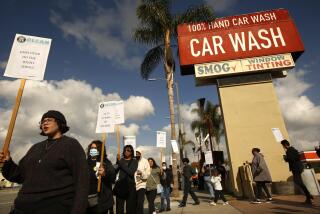Liability Suit System Needs an Overhaul
- Share via
Fearful of being sued over accidents and being forced to pay huge damage awards, parks remove diving boards from pools, schools cut back on playground equipment and companies drop product lines. Liability insurance premiums mushroom, and court dockets get jammed with cases.
Does this system of compensating injured parties make sense?
That question is being raised more often these days by insurers, lawmakers and legal scholars. State legislatures have been wrestling with laws to cap damage awards but in most cases with only a minor effect on overall cost. Trial lawyers and others contend that any effective legislation would impinge on the rights of the injured to recover through the courts and remove some of the pressure on governments, compani1702043745negligently.
Major reforms appear to be far distant. Yet it is clear that the current system creates massive injustices. The injured face long delays and sometimes prohibitive legal costs in attempting to recover financially. At the same time, the high cost of insuring against such losses places a hidden burden on consumers; the costs inevitably are passed along to them in the form of higher product prices and heavier taxes.
One of the most telling condemnations of the current system is the high cost of administering it, points out George Priest, director of the Center for Law, Economics and Public Policy at Yale University. An amount equal to 40% of the liability insurance premiums paid nationally is required to cover administration--in other words, to pay legal fees, court costs and other expenses rather than to compensate victims for losses. That compares to only 8% of Blue Cross and Blue Shield premiums that go for administration rather than actual health care.
Discriminatory Element
Priest also maintains that the system has a discriminatory element to it. The poor collect less because when they are injured, they suffer less lost income, the basis of many awards. Yet because most of the insurance cost is being passed through to the public, the poor in effect pay as much for this coverage as the rich.
The problem is one that originated with the courts themselves. It didn’t occur to most people to seek recompense for injury caused by a faulty product by suing the manufacturer until a body of legal opinion developed that made it fairly easy to do so. Responding to scholarly work on the subject, judges began in the 1960s to loosen significantly the interpretation of fault in product liability and other injury cases. Companies and other organizations became liable even when there wasn’t much they could have done to avoid the injury.
To put it another way, the courts established the concept that producers of products and dispensers of services will bear the cost of accidents related to the use of these products and services. It is, as Priest observes, a form of insurance coverage for individuals created through the legal system. While individuals generally insure themselves against losses caused by fire, theft and ill health, they are protected against loss from using products and services by tapping into the treasuries of the providers.
Because of its inefficiency and discriminatory aspects, it is a system that is “very hard to defend in terms of social policy,” he argues.
The question is how to change it. Any legislative effort in this direction probably would be overturned in the courtroom. Hence, it will fall to the judiciary to correct what it has wrought. That won’t happen rapidly, but at least there is a good bit more legal study under way into such reforms, work that ultimately will influence judicial decision making. “The thinking of legal scholars has really changed in the last five years,” Priest says.
One solution would be better individual insurance coverage against accident, injury and financial loss, much as personal medical and casualty insurance provides now. But that will develop only as it becomes more difficult to recover damages through the legal process.
Would a company that knowingly marketed a dangerous product be let off the hook too easily under such a system? That need not be the case. Standards of proof would be tougher, but punitive damages presumably still could be won through civil action.
More to Read
Inside the business of entertainment
The Wide Shot brings you news, analysis and insights on everything from streaming wars to production — and what it all means for the future.
You may occasionally receive promotional content from the Los Angeles Times.










